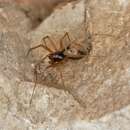en
names in breadcrumbs


The spider family Linyphiidae (sheetweb weavers) has a worldwide distribution and includes 4461 described species according to Platnick (2013), making it the second most species-rich spider family after the Salticidae (jumping spiders). The greatest number of linyphiid species are found in north temperate regions. Nearly a thousand linyphiid species are known to occur in North America north of Mexico, making Linyphiidae the most diverse spider family in this region, since only a few hundred salticids occur here.(Draney and Buckle 2005; Bradley 2013).
Many of the larger linyphiids are in the subfamily Linyphiinae, a group that includes around a third of linyphiids, among them several very familiar North American representatives such as the Hammock Spider (Pityohyphantes costatus), the Bowl and Doily Spider (Frontinella communis), and the Filmy Dome Spider (Neriene radiata). Around two thirds of linyphiids are placed in the subfamily Erigoninae ("dwarf sheetweavers"), which were formerly treated as the "micryphantids". Dwarf sheetweaver are among the world's smallest spiders, some of them measuring less than 1 mm long when fully grown. Dwarf sheetweavers either build inconspicuous webs near the ground or no web at all. They are most often noticed when ballooning: when conditions are just right (most often in autumn when the sun creates a warm rising air current), thousands of tiny ballooning spiders may drift down together and coat a fence or field with silk. This silk coating ("gossamer") is composed of thousands of thin silk strands. Close examination of a gossamer sheet can reveal hundreds of spiders running about trailing silk (and often becoming airborne again). (Bradley 2013)
Linyphiids often have large chelicerae with numerous teeth that can be seen under moderate magification. The eight small eyes are usually positioned far up on the face, above the tall clypeus that is typical of this group. The combination of tall chelicerae and high clypeus gives sheetweb weavers a a distinctive face. Some dwarf sheetweaver males have unusual head morphologies with horns, lumps, or pits. This ornamentation is related to mating. Females may grasp these head ornamentations with their fangs during mating and in a few species the pits have been shown to contain numerous glands, which may secrete female attractants. (Bradley 2013)
Linyphiids construct semi-permanent webs consisting of one or more horizontal sheets of silk which are often supported above and below by auxiliary support lines. The spider generally hangs upside down beneath the primary sheet (or near the edge). There is usually a tangle of knockdown threads either above and/or below the sheet. The knockdown threads intercept flying insects, which blunder into them and are slowed or tumble down onto the sheet. Similar threads under the sheet may act to warn the spider of approaching danger or prey emerging from below. When a prey item strikes the web, the spider rushes out to capture it. Because the spider is beneath the sheet, it bites through the web to capture and subdue the prey, which is then pulled through the web, wrapped with more silk, and consumed. The sheet web silk is generally not sticky, but the prey is slowed by the difficulty of walking over the netlike sheet interspersed with trip lines. (Draney and Buckle 2005; Bradley 2013)
Most linyphiids live in leaf litter or on the ground, but some (especially larger species) build webs in vegetation. Both myrmecophiles (ant associates) and cavernicoles (cave-dwellers) are known. Linyphiids generally feed on small, soft bodied arthropods, especially collembolans and flies. They are found in nearly all habitats, but are most diverse and abundant in more mesic to hydric (i.e., wetland) areas and are prominent in northern peatlands. Most species are univoltine or annual (one generation/year), but multivoltine (more than one generation/year) and merovoltine (more than one year/generation) life histories are also common. Adults of most species are present for just a brief period each year, but some multivoltine and merovoltine species are active as adults during most or all of the year. Most species overwinter as juveniles or adults—some are even active under snow in winter—but a few overwinter as eggs. (Draney and Buckle 2005) Draney and Buckle (2005) reviewed the biology of linyphiids and cite key references as of 2005.
Linyphiidae is a large and taxonomically difficult family. Identification of genera and species is not for the faint of heart, but Draney and Buckle (2005) provide keys to the genera occurring in North America north of Mexico (and references for generic revisions where available). Although some genera have been recently revised, most have not. Several known genera and many species remain undescribed. Draney and Buckle (2005) reviewed the taxonomic history of North American linyphiids and provided a compilation of key references. Paquin and Dupérré (2003, 2006) illustrate all linyphiid species known from Quebec, providing a valuable resource for identifying linyphiids elsewhere in northern and eastern North America as well. LinyGen (Hormiga et al. 2008) is an online resource that includes illustration of all linyphiid genera worldwide.